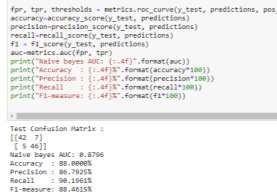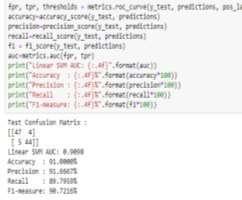https://doi.org/10.22214/ijraset.2023.48678

ISSN: 2321-9653; IC Value: 45.98; SJ Impact Factor: 7.538
Volume 11 Issue I Jan 2023- Available at www.ijraset.com

https://doi.org/10.22214/ijraset.2023.48678

ISSN: 2321-9653; IC Value: 45.98; SJ Impact Factor: 7.538
Volume 11 Issue I Jan 2023- Available at www.ijraset.com

Abstract: Any opinion of a person that can convey emotions, attitudes, or opinions is known as a sentiment. The data analyzes that are collected from media reports, consumer ratings, social network posts, or microblogging sites are classified as opinion mining research. Analysis of sentiment should be viewed as a way of evaluating people for particular incidents, labels, goods, or businesses. The amount of views exchanged by people in micro-logging sites often increases, which makes nostalgic interpretations more and more common today. All sentiments may be categorized as optimistic, negative, or neutral under three groups. The characteristics are derived from the document term matrix using a bi-gram modeling technique. The sentiments are categorized among positive and negative sentiments. In this analysis, the Python language is used to apply the classification algo for the data obtained. The detailed accomplishment of LinSVC demonstrates greater precision than other algos.
Keywords: Sentiment Analysis, Classification Techniques, Naïve Bayes, Voting, Linear SVC , NLP,Data mining, amazon product review dataset.
The current Internet era has been an enormous cyber database that houses vast amounts of data that users generate or use. The database has expanded at an unprecedented rate, generating a digital market of consumerssharing their opinions on Facebook, Twitter, Rotten Tomatoes, and Foursquare. Opinions shared as comments offer new study tools to recognize the mutual desires or dislikes of cyber societies. The category of analysis that impacts everyone from the viewer, film reviewers to the production team, is one of these areas of reviews. The film reviews on the blogs are not systematic reports, but rather casual and unstructured. The viewpoints conveyed in filmreviews represent quite accurately the sentiment transmitted. The inclusion of such broad usage of words to describe the revisions inspired us to evaluate the polarity of the film in suchterms of feeling. Sentiment Analysis is a technology that will be relevant over the next few years. With opinion processing, we can differentiate bad content from highqualitymaterial.Throughcurrenttechnology,wewilllearnifafilmhasbetterviewsorpoorviewsandwhytheseviewsaregoodor negative. In this area, a significant proportion of early work centered on user feedback, such as feedback onAmazon.com[1], describing sentiments as favorable, negative, or neutral. The majority of sentiment analysis studies currently rely on social networking sites like IMDB, Twitter [2] & Facebook, which need the correct methods to satisfy through text demand. In comparison,thestudyofthesentencesin film reportsisa difficult task. ResearchSentiment Mining is aprocess focusedon the NLP or information extraction (IE) approaches to review a broad variety of documents such that the views of different writers can be collected[3]. This method includes a variety of techniques, including machine etymology and IR [4]. The fundamental principle of sentimentanalysisistorecognizeanddefinethepolarityoftextorshortmessages. True,"negative,"or"impartial"(neutral)opinion polarityisclassified.Itmustbeemphasizedthatemotionminingmay becarriedoutinthefollowingthreestages.[5]:
1) Classificationofsentimentatadocumentlevel: atthispoint,atextmaycompletelybecategorizedas"positive"or"neutral."
2) Classificationofsentences:Eachsentenceshallbecategorizedas'yes,''no'or'unbiased.'
3) Sensitivity classificationofdimensionortypeoffeatures:atthispoint,phrases/documentsmaybecategorizedas«positive»,« negative»or«non-party»providedthoseaspectsofsentences/archivesbutgenerallyrecognizedas«viewgroupingof the viewpointstage.
The paper research that we present takes account of previousstudies in the issue field of opinion analysis in film reviews. Stefano, Andrea& Fabrizioin[6]PresentSentiWordNet3.0,a lexicaltoolparticularlybuilt fortheclassification of sentiment.SentiWordNet 3.0 is a science collaborative platform and has been approved in over 300 study groups at present.Senti WordNet 3.0 focuses especially on aspectenhancements (the algos used for WordNet annotation) it includes. Godbole, Manjunath & Stevens in their work[7]Currentto eachdistinctentityintextcorpusaframeworkwhichquantifiespositiveornegativeopinion.
ISSN: 2321-9653; IC Value: 45.98; SJ Impact Factor: 7.538

Volume 11 Issue I Jan 2023- Available at www.ijraset.com
It consists of twostages, one stage in which sentiment perception is decided byperceptions and one step in which a relative score is defined for each person. Annett &Kondark [8]It was noted that the MLsentimental classification methodology on film review is very effective and thatthekind offeaturespickedhasa significanteffectonthe classifier's accuracy.Sincethere isan upperlimit to the exactness point, as is apparent in a dictionary- based method. Pang & Lee work [9]is known in sentimental movie review researchasastandard.Theproblemisnotgradedbysubjectmatter,butbygeneralemotion,e.g.whetheracommentisgoodorbad. They claimed thatclassical learning methodsin machineshave stronger performance thanbaselinesmade. Though, 3 approachesof machine learning (Naive Bayes, maximum entropy classification &SVM do not have such strong results in the classification of emotions as in the conventional subject classification. They also derive and introduce productive methods for the quest for minimum cuts in graphs; this significantly favors the fulfillment of cross sentences semantic constraints, which offer an excellent means of combining conceptual knowledge at an interdenticle level for conventional word dictionaries. Singh et al. [10]Present the theoretical research on the SentiWordNet results assessment method for classifying film reviews and blog posts on documentary feelings. Similar to two common machine- learning methods they made improvements in semantic functions, ranking schemes, and thresholds of the SentiWordNet method. Comparative outcomes in film reviews and forum posts are demonstrated by normal precision, F- measure, or Entropy efficiency assessment measures. Chunxu Wu [11]Proposed a system for integration of contextdependent views semantic by WordNet. To order to assess opinion by way of semantic closeness tests, the approachsuggested is used. This methodology depends on these stepsto assess the subject of feedback where inadequate knowledge is accessible. Taboada et al. [12]Used a strategy of lexicon-dependent identification and interpretation of documents depending on their emotions. Strong or derogatory lexicons have been used to do this correctly. Furthermore, the simulator of semantic orientation (SO-CAL) focused on intensifiers and negations is introduced. This method has reached an accuracy of 76.37 percent in film reviews. Zagibalov et al. [13]Addressed the problem of classifying the feelings in consumers in Chinese written goods. Their method relied on unattended classification underwhich the vocabulary seed was born. Initially, there was only one (good) term identified as optimistic. The first seed was retrained iteratively to identify emotions. The criteria for opinion density is then used to measure the feels ratio for a paper. The tests demonstrated that after 20 iterations, the qualified classifier obtained an 87% FSR for dramaticpolaritydetection. Tripathy et al. [14]Tried to distinguish feedback by polarity with supervised learning algos like Naïve Bayes, SVM, random forest, or linear discriminant analysis. Inachieving so, four phases were included in the solution suggested. The first step was to delete stopping words, mathematical characters, and individual characters. Second, text comments have been translatedintoanumericalmatrix.Thirdly,vectorscreatedforfourdifferentclassifierswereusedasinputs.Variousparameterswere thenmeasuredtoassesstheefficiencyoftheproposednmethod,e.g.precision,alert,f-measurement,orclassificationaccuracy.The random forest classifier surpassed many classifiers for Polarity & IMDb datasets. Saleh et al. [15]To distinguish paper evaluations, the SVM was applied to 3 separate datasets. To determine the effect of the SVM in classification papers, many n-gram schemes have been used. The researchers used three weighing methods to produce vectors of function: Term Frequency, Conditional Occurrence,andTermFrequencyInverseDocumentFrequency(TFIDF).

The algo workswith probabilistic,and thealgo workswith differentmeasures. The datacollection will beevaluated before analysis so each sentence in the dataset is split into terms so each word's polarity will be evaluated. The term polarity may be viewed as positive or negative in a tabulated form as seen in figure 1. The algorithm is introduced to the dataset following this procedure. Word level research is the strongest as it is most likely to produce reliable information. The next step is to implement algo suggested as each term is measured in two groups (positive or negative) with both positive and negative probability. The higher probabilityclassificationisdefinedascorresponding sentenceprobability.
ISSN: 2321-9653; IC Value: 45.98; SJ Impact Factor: 7.538

Volume 11 Issue I Jan 2023- Available at www.ijraset.com
This dataset contains user ratings and Amazon documentation as shown in figure 2. This data collection includes comments (ratings,text,votesforhelpfulness),productmetadata(descriptions,detailsincategory,size,brand,orimages) orlinks(alsoseenor boughtgraphs).


Preprocessing data is a technique in data mining that allows raw data to be converted into an understandable format. Real-world statisticsareoftenincomplete,unreliable,or deficientinanyactionorpatterns,andincludeseveralmistakes.Preprocessingdataisa well-proven approach to overcome such problems. For more analysis, computer preprocessing prepares raw data. We removed unique characters and numeric values for our study and translated allletters into smaller instances. Snowball stemmer: a little string processing language for the development of stemming algos for knowledge retrieval. Snowball: Snowball Stemming effectively eliminates a term suffix or returns it to its source term. For eg, if we take "ing" from "flying" we get a term or a root term from "flying.""flying"isaverb,and thesuffixisan"ing" "ing." This suffix is used to build a separate term fromthe initial. The word matrix of a concept is then defined asThe term frequency for each word is recorded in each case byconcept term. We begin with the Words Sack, which displays the documents and then count the number of occasions a word appears within each text. The next step isto splitthe data between preparation and assessments by splitting the data collection between 90% or 10%.Theevaluation of data collection would be evaluated. The next step is to submit the classification algorithm and get the results. A vote is one of the easiest ways to merge several learning algos with predictions. Voting classification is not a classifier but a wrapper for different onesthathavebeenequippedandratedconcurrentlytotakeadvantageofthe distinctcharacteristicsofeachalgo.
Linear SVC: A Linear SVC aims to match the data you have and return the "right fit" hyperplane, which separates or classifies the information. This is also the intention of a LinearSVC classification algo. You should then feed some elementsinto your classifier aftergettinghyperplaneandseewhat"predicted"typeis.Thisrendersthisspecificalgomoreappropriateforouruse.
ISSN: 2321-9653; IC Value: 45.98; SJ Impact Factor: 7.538

Volume 11 Issue I Jan 2023- Available at www.ijraset.com
IV. RESULTSANDDISCUSSION

Precision or recall levels are measured, and 91.66% or 89.79% of meaning are collected. The average accuracy is 91%. The precisionof91 percent indicates that LinSVCalgoishigherthantheothertwoalgosinclassification.

AUC — ROC is a classification problem output calculation at various levels. ROC is a chance curve and AUC is a degreeor separability metric. This asks how many models will discriminate between groups. As AUC is larger, the stronger the pattern is 0s aszeroand1sas1s.
©IJRASET:AllRightsareReserved|SJImpactFactor7.538|ISRAJournalImpactFactor7.894|

ISSN: 2321-9653; IC Value: 45.98; SJ Impact Factor: 7.538



Volume 11 Issue I Jan 2023- Available at www.ijraset.com

ISSN: 2321-9653; IC Value: 45.98; SJ Impact Factor: 7.538

Volume 11 Issue I Jan 2023- Available at www.ijraset.com
Figure 11 indicates the LinSVC's maximum false-positive rate in a study of three classification algos. That is a percentage between the number of adverse outcomes mistakenly definedas positive (false positive) and the total amount of true negative incidents (unlesstheratingisconsidered)


The primary objective of the sentimental analysis is to recognize the text according to its polarity. Opinion Mining is one of the sentimental analysis's major categories. The opinion of every consumer purchasing a product or reviewing a film relates significantly to the product or film This paper suggests an opinion analysis system for the amazon review toidentify comments received from UCI Website either positivelyor negatively.The proposed approach is applied to this review dataset and obtained an accuracyof91%byLinSVCoverNBandVoting.
©IJRASET:AllRightsareReserved|SJImpactFactor7.538|ISRAJournalImpactFactor7.894|
ISSN: 2321-9653; IC Value: 45.98; SJ Impact Factor: 7.538

Volume 11 Issue I Jan 2023- Available at www.ijraset.com
[1] Gregory,Michelle L.,etal. "User-directedsentiment analysis: Visualizingthe affectivecontentofdocuments."Proceedingsofthe WorkshoponSentiment and Subjectivity inText.AssociationforComputationalLinguistics,2006.
[2] Pak,Alexander,andPatrickParoubek."TwitterasaCorpusforSentimentAnalysisand OpinionMining."LREC.Vol.10.
[3] R.Xia,C.Zong,andS.Li,"Ensemble offeaturesetsand classification algorithmsforsentimentclassification,"InformationSciences,vol.181,no.6,pp.11381152,2011/03/15/2011.
[4] R.Sharma,S.Nigam,andR.Jain,"Opinionminingofmoviereviews atdocumentlevel,"arXivpreprintarXiv:1408.3829,2014.
[5] R.Sharma,S.Nigam,andR.Jain,"Polaritydetectionatthe sentencelevel,"InternationalJournalofComputerApplications,vol.86,no.11,2014.
[6] Baccianella, Stefano, Andrea Esuli, andFabrizioSebastiani. "SentiWordNet 3.0: An Enhanced Lexical Resource for Sentiment Analysis and Opinion Mining." LREC.Vol.10.2010.
[7] Godbole,Namrata,ManjaSrinivasaiah,andStevenSkiena."Large-ScaleSentimentAnalysisforNewsand Blogs."ICWSM7(2007):21.
[8] Annett, Michelle, and GrzegorzKondrak. "A comparisonof sentiment analysis techniques: Polarizing movie blogs." Advances in artificial intelligence. SpringerBerlinHeidelberg,2008.25-35.
[9] Pang, Bo, Lillian Lee, and ShivakumarVaithyanathan. "Thumbs up?: sentiment classification using machine learning techniques." Proceedings of the ACL-02 conferenceonEmpiricalmethodsinnaturallanguage processing-Volume10.AssociationforComputationalLinguistics,2002.
[10] Pang, Bo, and Lillian Lee. "A sentimental education: Sentiment analysis using subjectivity summarization based on minimumcuts." Proceedings of the 42nd annualmeetingon Association forComputationalLinguistics.Association forComputationalLinguistics,2004.
[11] C. Wu, L. Shen, and X. Wang, "A new method of using contextual information to infer the semantic orientations of context-dependent opinions," in Artificial Intelligence and ComputationalIntelligence2009. AICI'09. International Conference on, 2009, vol. 4:IEEE,pp.274-278.
[12] M.Taboada,J.Brooke,M.Tofiloski,K.Voll,andM.Stede,"Lexiconbasedmethodsforsentimentanalysis,"Computationallinguistics,vol.37,no.2,pp.267307,2011.
